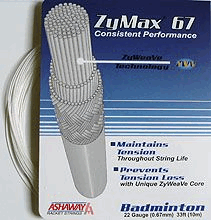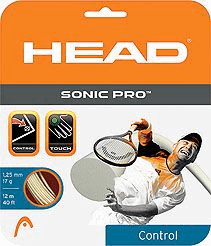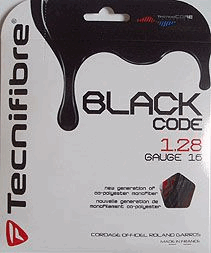Strings, Gauge & Tension
The string market is large, and there is a huge number of brands offering a diversity of strings under their label. Every string has its unique characteristics. Although there are a lot of physical attributes (material, structure, gauge, color, surface etc.) that can be altered during string production, there are certain main features I want to describe below.
You can divide tennis strings into two main categories: natural gut and synthetic string.
Natural Gut
Natural gut strings are made of 'cows' gut in a complex process. Their main features are superb elasticity, tension stability and "liveliness". But they are very expensive and sensitive to weather, while one has to say that a lot of improvement has been made in this respect during the past few years. Still many of the pros play natural gut, but I don't recommend natural gut for the normal club level player, since those players should use strings with better price/performance ratios.
Examples for natural gut strings: Babolat VS Team
Examples for natural gut strings: Babolat VS Team
Synthetic Strings
Synthetic strings are mostly high tech products which are constantly being improved to bring their playability into line with natural gut strings but keep the advantage of the synthetic materials' higher durability. There's a great diversity of different structures and materials. Let me briefly explain the main categories:
Nylon Strings
The most frequently used string type. Nylon strings are among the most reasonable tennis strings and are normally made of a single nylon core and various resistant wraps. Due to its excellent dynamic properties nylon (polyamide) is well suited as a material for tennis strings. The high number of different types of constructions (wrap material and wrap angle) influence the string's playing characteristics significantly.
As a rule of thumb, nylon strings with multiple wraps can be considered higher grade than single wrap nylon strings. The wraps reduce the tension loss usually experienced with nylon strings. Nylon strings are suitable for players who have a normal or high string consumption.
Examples: Babolat Powergy, and Prince Tournament Nylon.
Examples: Babolat Powergy, and Prince Tournament Nylon.
Polyester Strings
Polyester strings show a fairly simple structure: they consist of a single polyester fiber with a thin coating. This type of construction is termed "monofilament". They come in different gauges (1.10-1.35mm) which enables you to choose among different elasticity/durability levels. Polyester strings are little elastic and feel quite stiff compared to nylon or multifilament strings, but on the other hand they provide significantly better durability, allowing for thinner gauges. Pure polyester strings like the Polystar Classic or the Kirschbaum Super Smash have one main downside: They tend to lose their tension quite quickly, so control decreases and the string feels dead after a short time of play. Thus polyester strings are only recommendable for players with high string consumption. For these players, polyester strings offer a great price/performance ratio.
During the past few years, tremendous effort has been put into the advancement of monofilament strings and the elimination of their major weaknesses (tension loss and lack of elasticity). Luxilon has specialized in this string category. More and more polyester blends (co-polyester), mixed with a number of other materials like PEEK, carbon or metallic fibers, are being developed to modify the playing characteristics. Almost every manufacturer carries such strings in their program today.
Examples: Luxilon Big Banger Alu Power, Head Ultra Tour.
Examples: Luxilon Big Banger Alu Power, Head Ultra Tour.
Multifilament Strings
To bring synthetic strings' playability more into line with natural gut, many microfibers (which can be of many different materials) are twisted together to a string, which is wrapped with a resisant cover. Advantage: higher elasticity and better playability.
Disadvantage: multifilament strings tend to break soon once the outer wrap is damaged (the strings "fray"). Also these strings cost more than nylon strings because of the complex manufacturing process. Examples are Babolat XCel Premium
Structured Strings
Structured (textured) strings are designed to provide better ball bite and thus enhanced spin. Most of these strings indeed offer great spin potential and in line with that better control,
but unfortunately the texture usually wears within a short time and the strings become smooth.
Examples are Babolat conquest
Examples are Babolat conquest
Hybrid Strings
Hybrid strings are a combination of two different strings for mains and crosses. In a uniformly strung racquet it's almost always a main string that breaks. This is because the main strings move a lot more than the cross strings so the cross strings "saw" into the main strings, causing notches and eventually breakage. That's why in hybrid strings usually a durable string is used as the main string (e.g. polyester or aramid/ kevlar/ technora). As cross strings usually highly elastic synthetic strings or natural gut strings are used to provide comfort and feel.

Hybrids provide good playing characteristics while a poly/multi hybrid often lasts longer than a pure poly or pure multifilament string job. There is an almost infinite number of possible string combinations. As you can create highly individual combos, hybrid strings are becoming more and more popular. There are also some pre-packaged hybrids available from the major string brands.


